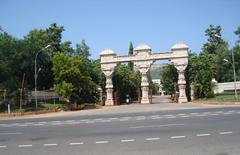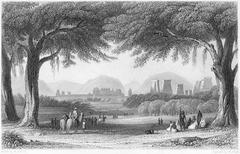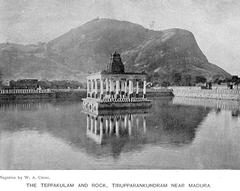
Visiting Hours, Tickets, and Historical Significance of Kazimar Big Mosque, Madurai
Date: 24/07/2024
Introduction to Kazimar Big Mosque
Kazimar Big Mosque, also known as Kazimar Periya Pallivasal, stands as a monumental testament to Madurai’s rich cultural and religious history. Established in 1284 AD by Hazrat Kazi Syed Tajuddin, a direct descendant of the Prophet Muhammad, this mosque is the oldest in Madurai, Tamil Nadu, India. Over the centuries, it has evolved from a relatively small structure to a grand architectural marvel accommodating around 2,500 worshippers (Tamil Nadu Tourism). Blending Islamic and Dravidian architectural styles, the mosque features intricate carvings, domes, and minarets, making it a significant landmark not just for its religious importance but also for its aesthetic beauty (Madurai Tourism). Beyond its architectural splendor, the mosque serves as a Madrasa, providing religious education and Arabic language learning. The complex also houses the Madurai Maqbara, a dargah containing the tombs of revered Hazrats, adding layers of religious and cultural significance (Madurai Tourism). Managed by the descendants of its founder for over seven centuries, Kazimar Big Mosque is not just a place of worship but a hub for social welfare activities and community service. This guide aims to provide comprehensive information to potential visitors, covering everything from historical background and architectural details to practical visitor tips and nearby attractions, ensuring a well-rounded understanding of this iconic site.
Table of Contents
History and Significance
Historical Background
Kazimar Big Mosque, also known as Kazimar Periya Pallivasal, holds the distinction of being the oldest mosque in Madurai. Constructed in 1284 AD (Hijri 683), the mosque was established by Hazrat Kazi Syed Tajuddin, a revered Islamic scholar and saint who was a direct descendant of the Prophet Muhammad. Syed Tajuddin migrated from Yemen to India during the 13th century and was granted land by King Kulasekara of the Pandyan Dynasty to build the mosque (Tamil Nadu Tourism). The mosque’s original structure was relatively small, but it has undergone numerous renovations and expansions over the centuries to accommodate the growing Muslim community in Madurai. Today, the mosque can host around 2,500 worshippers at a time (Madurai Tourism).
Architectural Significance
Kazimar Big Mosque is an architectural marvel that showcases a blend of Islamic and Dravidian styles. The mosque features arches, domes, minarets, and intricate carvings that are characteristic of Islamic architecture. The main prayer hall is spacious and adorned with beautiful inscriptions and verses from the Quran. One of the unique features of the mosque is its magnificent gate, which is decorated with intricate patterns and Arabic inscriptions (Tamil Nadu Tourism).
Religious and Cultural Importance
The mosque is not only a place of worship but also serves as a Madrasa (Islamic school) where students receive religious education and learn Arabic. The Hazrat Kazi Syed Tajuddin Arabi Madrasa, located within the mosque complex, is an important center for Arabic learning. Many students come here to learn the ancient traditions of Islam (Madurai Tourism). Kazimar Big Mosque also houses a popular dargah (mausoleum) known as Madurai Maqbara. The maqbara contains the tombs of prominent Hazrats of Madurai, including Hazrat Meer Amjad Ibrahim, Hazrat Syed Abdus Salaam Ibrahim Rahmatullahi Alaihim, and Hazrat Meer Ahmad Ibrahim, who are also considered to be descendants of Prophet Muhammad (Madurai Tourism).
Management and Administration
The mosque has been managed by the descendants of Kazi Syed Tajuddin for over seven centuries. These descendants, known as Huqdars, have lived in the same locality (Kazimar Street) for generations. The management committee of the mosque is selected from these Huqdars and consists of four board members who serve a term of three years each (Wikipedia).
Social Contributions
Kazimar Big Mosque is actively involved in charitable work, providing assistance to those in need through various programs such as free medical centers, food distribution, and financial assistance. This makes the mosque not only a religious center but also a hub for social welfare activities in the community (Tamil Nadu Tourism).
Visitor Information
Visiting Hours and Dress Code
The mosque is open to visitors from 5:00 AM to 8:00 PM. Visitors are advised to wear clothes that cover the upper body entirely and cover their legs below the knees. Footwear must be left outside the place of worship (Tamil Nadu Tourism).
Ticket Prices and Guided Tours
There is no entry fee to visit the Kazimar Big Mosque. Guided tours can be arranged upon request, providing visitors with in-depth knowledge about the mosque’s history and significance.
Accessibility and Travel Tips
The mosque is accessible to people of all ages. It is advisable to visit early in the morning or late in the evening to avoid the peak hours and enjoy a peaceful experience. Photography is allowed but should be done respectfully.
Nearby Attractions
The mosque is located near several other significant landmarks, including the Meenakshi Amman Temple, Tirumalai Nayakkar Mahal, Pasumalai Hills, and Raja Aquarium. This proximity to other attractions makes it convenient for tourists to explore multiple sites in a single visit (Madurai Tourism).
How to Reach
The nearest airport is Madurai Airport, located 11 km away from the mosque. Madurai Railway Station is the closest train junction, situated just 2 km from the mosque. The Periyar bus stand is also nearby, making it easily accessible by various modes of transportation (Tamil Nadu Tourism).
FAQ
What are the visiting hours for Kazimar Big Mosque?
The mosque is open to visitors from 5:00 AM to 8:00 PM daily.
Is there an entry fee to visit Kazimar Big Mosque?
No, there is no entry fee to visit the mosque.
Are guided tours available?
Yes, guided tours can be arranged upon request.
What is the dress code for visiting the mosque?
Visitors should wear clothes that cover the upper body entirely and cover their legs below the knees. Footwear must be left outside the place of worship.
How can I get to Kazimar Big Mosque?
The mosque is located 500 meters from the central bus stand and about 1 km from the Madurai railway station.
Can I take photographs inside Kazimar Big Mosque?
Photography may be restricted in certain areas. It is best to seek permission before taking pictures.
Conclusion
Kazimar Big Mosque stands as a testament to the rich cultural and religious history of Madurai. Its architectural beauty, historical significance, and social contributions make it a must-visit destination for anyone exploring the city. Managed by the descendants of Hazrat Kazi Syed Tajuddin for over seven centuries, the mosque continues to play a crucial role in the lives of its local community. Visitors can appreciate the mosque’s architectural grandeur, participate in guided tours to learn about its history, and engage in the vibrant community life that surrounds it. Its proximity to other historical landmarks like the Meenakshi Amman Temple and Thirumalai Nayakkar Mahal makes it convenient for tourists to explore multiple sites in a single visit. Whether you are a history enthusiast, an architecture aficionado, or a spiritual seeker, Kazimar Big Mosque offers an enriching and enlightening experience. For more travel guides and updates, be sure to download the Audiala app and follow us on social media.
References and Further Reading
- Tamil Nadu Tourism. (n.d.). Kazimar Periya Pallivasal Madurai. https://www.tamilnadutourism.com/attractions/darghas/kazimar-periya-pallivasal-madurai.php
- Madurai Tourism. (n.d.). Kazimar Big Mosque Madurai. https://maduraitourism.co.in/kazimar-big-mosque-madurai





